Her body, her choice
The Tokyo Olympics has seen female athletes defy sexist clothing rules; this resistance was long overdue

To be a woman is to be told what to do. Religious books, laws, diktats, guidance, rules — through the ages all of these have been written by men, and among other instructions, they have essentially set out to tell a gender completely different from their own, how to conduct themselves. Obviously, these rules have been challenged by resolute women, who not only refused to follow the commands of men but also dared to change them.
Even today, guidelines set by men are being defied by women. In some cultures, men have forced women to cover up from head to toe while in some they have been ordered to don skimpy uniforms with overtly sexual overtones. The discussion over the clothing of sportswomen has been triggered once again, this time at the Tokyo Olympics. It started when the Norwegian female volleyball team refused to wear bikini bottoms during a match against Spain and swapped them for the comfortable and more utilitarian shorts. Each player was fined 50 euros by the European Handball Federation, which created a huge uproar. German gymnasts followed suit by opting to wear unitards rather than their usual lingerie-like apparels.
For far too long, women in competing sports have been compelled to dress a certain way — a way that sexualises them and their body parts even if they don't want it. The dress code for some of the games in the Olympics have been sexist for a while but have been tolerated in silence. This time though, history is being etched with the female resistance against the sexist clothing gaining momentum. Sporting outfits are meant to be functional and aid performance, however, unnecessary sexualisation of the uniform only draws attention away from the athlete's prowess and grit, and more to their bodies. Objectification of the female form has long been a factor of discomfort to female athletes.
These clothing rules are apparently put in place by the federations of each sport, obviously men. Volleyball, gymnastics, figure skating — all have uniforms that exude sexuality. While male volleyball players wear loose tops and shorts, women wear tank tops with their stomachs showing and bikini bottoms (just read this rule about female clothing in volleyball) "with a close fit and cut on an upward angle toward the top of the leg" and a maximum side width of four inches. Going by the aesthetics of their clothing, the women rolling in the sand are to perform, not for the sport, but for the lascivious eye of the male observer.
Interestingly, the so-called rules were quite different when women were first allowed to participate in the Olympics in 1900. Women were made to cover up with long dresses, high necks, and loose sleeves. This was done so that men don't get distracted by their female counterparts. In 1908, the bottom half of the legs could be shown but uniforms were still conservative, and over the years, with women breaking (yes, 'breaking' not 'making' because that's how hard they had to push to compete in the Olympics) their way into newer sports, the uniforms too evolved. The evolution of sporting attire happened with a view to make female clothing more feminine to take away from the masculinity of competing in sports (yes, rolling my eyes while I write this) while still helping the women attract husbands. So, whether the women were asked to hide their sexuality a century ago or expose it now, the 'rules' were always spelt out by men; women played no role. It's in this context that the revolt of these gutsy women at the Tokyo Olympics gains importance.
Some sportswomen have a flamboyant style; their various looks, like with Serena and Venus Williams, often create headlines. But it's always been their decision to dress the way they want, pushing their limits of comfort and agility. They are not governed by rules that compel them to cavort about in revealing garments even when they don't want to. British Paralympian Olivia Breen, who is participating in the Tokyo Olympics said she was "disgusted" when an official told her that her shorts were, well, too short. How female athletes decide to dress and determine their comfort levels, is best left to them. No matter what the woman decides to do, flaunt or cover her body, should ultimately be her choice — her body, her rules, right?
The writer is an author and media entrepreneur. Views expressed are personal



